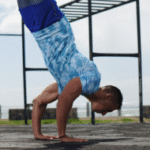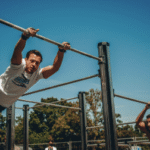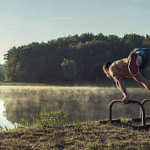What Really Happens During a One-on-One Calisthenics Session?
The Initial Check-in & Assessment (5-10 minutes): Beyond Just Greetings
The session begins with a focused dialogue that sets the stage for the workout:
Verbal Check-in: Your coach will actively engage you in a conversation about your previous week’s training – how you felt, any new muscle soreness or unusual aches, the quality of your sleep, and any external stressors (common for busy Houston professionals navigating a demanding city). This immediate feedback allows the coach to make real-time, on-the-fly adjustments to the day’s plan, ensuring you’re not pushed beyond your current recovery capacity.
Review of “Homework”: If you were given independent drills, mobility work, or specific practice to do between sessions, the coach will inquire about your progress, successes, and any challenges or points of confusion encountered.
Quick Movement Screen/Mobility Assessment: The coach might conduct a brief, targeted assessment by observing a few specific movements or testing a particular joint’s range of motion (e.g., assessing shoulder flexion for overhead skills like handstands, or wrist extension for planche progressions). This ensures optimal preparation and identifies any lingering limitations that need to be respected in the upcoming workout.
—
- The Warm-up (10-15 minutes): Purposeful Preparation
This is not a generic warm-up. It’s a carefully structured prelude meticulously designed to prime your body for the specific demands of the session:
Dynamic Mobility Drills: Active movements through your joints’ full range of motion (e.g., controlled arm circles, leg swings, spinal twists, cat-cow stretches). These are specifically chosen to prepare the exact joints and muscles that will be heavily utilized in the day’s skill work and strength training. For example, a session focused on pull-ups will feature extensive shoulder and scapular mobility drills.
Specific Muscle Activation: Exercises designed to “wake up” and engage key muscles that might be dormant or underactive (e.g., band pull-aparts for shoulder external rotators, glute bridges for hip activation). This ensures the correct muscles fire effectively from the start.
Low-Intensity Skill Priming: For advanced skills, the warm-up might include very easy, low-intensity versions of the actual movements (e.g., hollow body holds on the floor before attempting on the bar, light wrist rocks and shoulder leans for handstands) to prime the nervous system for the more complex movements to come.
Joint Preparation: Meticulous attention is given to joint-specific warm-ups, especially for the wrists (wrist circles, extensions, flexions with light pressure) and shoulders (scapular protractions/retractions), which bear significant load in calisthenics.
—
- The Core of the Session – Skill Acquisition & Practice (20-30 minutes): The Main Event
This is the heart of the private session, where the magic of personalization truly shines. The coach fluidly moves between skill acquisition and strength building, constantly adapting to your performance and providing unparalleled guidance:
Skill Work (The Calisthenics Focus):
Meticulous Breakdown & Progression: If you’re learning a handstand, muscle-up, planche, or front lever, the coach will meticulously deconstruct the complex movement into its smallest, most achievable component parts and prerequisites. They ensure you master each micro-step before advancing.
Targeted Drills: You’ll perform specific drills designed to isolate and strengthen the weakest links of the skill (e.g., wall handstand holds for alignment, arch hangs for back lever, false grip hangs for muscle-ups, specific core compressions for L-sits).
Progressive Regressions & Progressions: The coach has a vast repertoire of variations. If a movement is too difficult, they’ll immediately provide a simpler, effective regression that still targets the intended muscles. If you’re excelling, they’ll challenge you with a harder progression or a new variation on the spot.
Unwavering Form & Technique Focus: This is continuous and uncompromising. The coach provides constant, precise verbal cues (“squeeze your glutes,” “push the floor away through your shoulders,” “keep your core tight,” “point your toes”), tactile cues (gently touching a muscle to help you feel the contraction and activation), and visual cues (demonstrating the movement perfectly). They will stop you mid-repetition if your form breaks down, prioritizing perfection over volume.
Spotting for Safety and Confidence: For challenging or inverted movements (e.g., handstands away from the wall, muscle-up transitions), the coach provides direct physical spotting. This allows you to attempt ambitious holds or transitions with confidence, knowing you’re safe, significantly reducing the psychological fear factor and preventing falls or injuries.
Video Analysis (Integrated): Many coaches actively record your sets (especially for skill work) with your smartphone or their own device. They will often review these videos with you directly after the set or at the end of the session, using slow-motion playback or drawing on the screen to highlight form flaws or areas of improvement. This visual feedback is incredibly powerful for accelerating learning and body awareness.
Strength Training (Building the Foundation for Skills):
Compound Bodyweight Exercises: You’ll perform a selection of fundamental pushing (e.g., advanced push-up variations, dips), pulling (e.g., pull-up variations, rows), leg exercises (e.g., pistol squats, weighted step-ups), and core work (e.g., L-sits, hollow body holds, dragon flags).
Manipulating Variables: The coach controls sets, reps, Time Under Tension (TUT – by prescribing specific eccentric or isometric hold durations), rest intervals, and intensity (using RPE – Rate of Perceived Exertion) to optimize for hypertrophy, strength, or endurance, depending on the current training mesocycle (block).
Weighted Calisthenics: For advanced clients who have mastered basic bodyweight movements, external weight (e.g., weighted vests, dip belts with plates) might be incorporated into exercises like pull-ups and dips to drive further strength and muscle growth.
Personalized Programming in Action: The coach dynamically adjusts the workout based on how you’re performing that specific day . If you’re showing signs of fatigue (e.g., from a demanding work week in downtown Houston) or energy is low, they might reduce volume or intensity. If you’re feeling exceptionally strong, they might challenge you with a new progression or a higher intensity method.
—
- Conditioning / Accessory Work (5-10 minutes): Refinement & Endurance
Towards the end of the main workout, there’s often a segment for higher-rep work, targeted exercises, or metabolic conditioning:
Higher Repetition Bodyweight Exercises: To build muscular endurance and increase metabolic stress.
Circuits or Supersets: Combining several exercises with minimal rest for cardiovascular and muscular conditioning, often to elevate heart rate.
Specific Accessory Exercises: Drills designed to address identified weaknesses or imbalances that might hinder skill acquisition or cause injury (e.g., specific rotator cuff exercises for shoulder health, targeted forearm conditioning for grip strength).
—
- Cool-down & Mobility / Flexibility (5-10 minutes): Recovery & Adaptation
The session concludes with essential steps for recovery, flexibility, and overall joint health:
Static Stretching: Holding stretches for the main muscle groups worked, to improve passive flexibility and aid in muscle relaxation.
Longer-Hold Mobility Drills: Specific exercises to improve active range of motion in key joints that were targeted during the session (e.g., deep hip flexor stretches, specific shoulder capsule mobility drills).
Foam Rolling / Self-Myofascial Release (SMR): The coach might guide you through SMR techniques using foam rollers or lacrosse balls to release muscle tightness and improve tissue quality, aiding in recovery.
Brief Debrief on Next Steps: A quick discussion about how you’re feeling physically and mentally after the workout, and a preview of the plan for the upcoming days.
—
- The Post-Session Debrief & Homework (5 minutes): Beyond the Hour
The coaching relationship extends beyond the session’s duration:
Session Review: The coach will summarize the highlights of the session, discuss successes, acknowledge challenges, and clarify key takeaways.
“Homework” & Next Steps: You’ll typically receive specific assignments – these could be mobility drills to perform daily, foundational exercises to practice independently, active recovery strategies, or a reminder of your personalized program for self-guided workouts. This ensures continuous progress between paid sessions.
Reinforcement of Holistic Strategies: Discussion about the ongoing importance of nutrition (fueling performance and recovery), consistent hydration (crucial in Houston’s climate), and adequate sleep for optimal physical adaptation.
Scheduling: Confirming the next session to maintain consistency in your training plan.
Houston Context:
In Houston, you can experience this detailed session structure in various settings. Your private calisthenics coach might operate from a specialized calisthenics studio (like Calisthenics & Lifestyle Club Houston ), utilize Houston’s expansive public parks with outdoor fitness areas (like Memorial Park or Buffalo Bayou Park ), or even conduct sessions in the convenience of your home or apartment gym . Regardless of location, the core elements of personalization and expert guidance remain constant, ensuring you get the most out of every minute.
—
Conclusion: A Comprehensive and Tailored Experience
A one-on-one calisthenics session is a comprehensive, meticulously planned, and dynamically executed experience. It’s not just about doing exercises; it’s about learning, adapting, and mastering your body under the precise guidance of an expert. From the initial check-in to the post-session debrief, every element is tailored to accelerate your results, optimize your form, prevent injuries, and ultimately, unlock your full physical potential in Houston.

What Really Happens During a One-on-One Calisthenics Session?
Route
Calisthenics Gym Houston Functional Bodyweight Training
Secondary phone: (346) 483-3195
Email: info@calisthenicsclubhouston.com
URL: https://calisthenicsclubhouston.com/
Monday 6:00 AM - 7:00 PM Tuesday 6:00 AM - 7:00 PM Open now Wednesday 6:00 AM - 7:00 PM Thursday 6:00 AM - 7:00 PM Friday 12:00 PM - 6:30 PM Saturday 9:45 AM - 12:00 PM Sunday 3:00 PM - 5:00 PM





